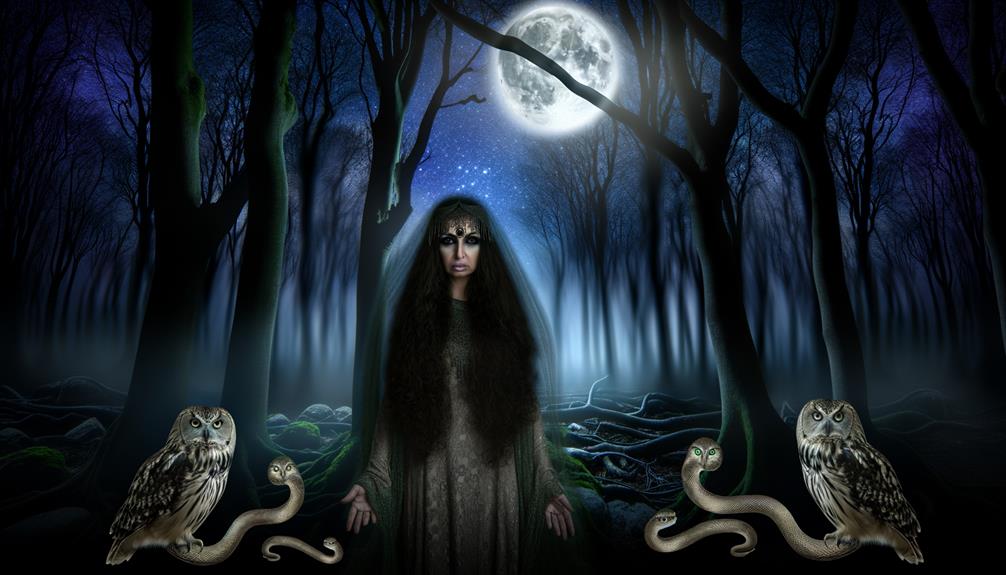Meaning of the Name Lilith
The name Lilith originates from the Sumerian word 'lilitu,' denoting night spirits with negative connotations. In ancient Mesopotamian texts, Lilith was associated with darkness and danger.
Jewish folklore further developed her narrative, portraying Lilith as Adam's first wife who defied subservience and fled Eden, maintaining her ties to the night and the demonic. Kabbalistic traditions imbued her with deeper symbolic meanings, representing untamed feminine power and cosmic balance.
Medieval and later interpretations reinforced her image as a seductive and rebellious figure. Today, Lilith is often seen as a symbol of empowerment and defiance, continuing to captivate cultural and scholarly interest.

Key Takeaways
- The name Lilith derives from the Sumerian word 'lilitu,' meaning night spirits with malevolent tendencies.
- In Hebrew, Lilith is linked to 'lailah,' emphasizing her association with night and darkness.
- Lilith symbolizes rebellion and independence, often depicted as Adam's first wife who fled Eden.
- In Kabbalah, Lilith represents the darker aspects of the divine feminine and untamed sexuality.
- Modern literature reimagines Lilith as a symbol of female empowerment and defiance.
Ancient Mesopotamian Origins
How did the name Lilith, with its rich tapestry of meanings and mythologies, originate in the ancient cultures of Mesopotamia?
The name Lilith is believed to derive from the Sumerian word 'lilitu,' which refers to a class of wind and storm demons. These entities were often depicted as night spirits with malevolent tendencies.
In Akkadian mythology, 'lilitu' evolved into 'Lilithu,' retaining its association with darkness and danger. Linguistically, the term is rooted in the Semitic word 'layl,' meaning 'night.'
Culturally, Lilith was portrayed in cuneiform tablets as an ominous figure, embodying the fears and uncertainties of the night. Hence, Lilith's name and character are deeply embedded in the linguistic and mythological fabric of ancient Mesopotamia, reflecting societal concerns and supernatural beliefs.
Lilith in Jewish Folklore
Building upon her ancient Mesopotamian origins, the figure of Lilith emerges in Jewish folklore as a complex and multifaceted character, often depicted as a rebellious and dangerous entity associated with night and the supernatural.
In texts such as the Alphabet of Ben-Sira, Lilith is portrayed as Adam's first wife who defied subservience and fled Eden. Linguistically, her name is linked to the Hebrew word 'lailah,' meaning night, reinforcing her association with darkness.
Cultural context reveals her role as a demonic figure, often blamed for infant mortality and seduction of men. This depiction reflects societal anxieties around autonomy and the unknown, solidifying Lilith as an enduring symbol of fear and fascination within Jewish tradition.
The Role in Kabbalah
In Kabbalah, Lilith is conceptualized as a powerful and malevolent force within the mystical framework, embodying the darker aspects of the divine feminine and serving as a counterpart to the Shekhinah. Rooted in esoteric traditions, Lilith is often depicted as an entity that defies patriarchal norms, symbolizing untamed sexuality and independence.
Linguistically, her name is linked to the Hebrew word ‘layil’ (night), signifying her association with darkness and mystery. Culturally, Lilith represents the shadow side of human nature, challenging the boundaries of moral and spiritual order. Legends and folklore often depict Lilith as a seductress and a temptress, embodying the fear of female empowerment and sexuality. The origins of the name Lizbeth can also be traced back to Lilith, with both names carrying connotations of darkness and enigma. The complex and multi-faceted nature of Lilith’s character continues to make her a compelling figure in various mythologies and belief systems.
In Kabbalistic texts, she is frequently portrayed as a seductress and a demon, highlighting her role in the cosmic balance between good and evil, light and dark.
Medieval Interpretations
Throughout the medieval period, Lilith was frequently reinterpreted by scholars and theologians, evolving into a complex figure symbolizing feminine rebellion and supernatural peril.
Medieval Jewish texts, such as the Alphabet of Ben-Sira, expanded her narrative as Adam's first wife who defied subservience. This portrayal intertwined with Christian demonology, where Lilith was cast as a night demon preying on newborns and pregnant women. Linguistically, her association with the Hebrew word 'lilith' (night creature) deepened these ominous connotations.
Cultural context from medieval Europe further amplified her image as an emblem of dangerous seduction and female autonomy, reflecting societal anxieties about uncontrolled female power. These interpretations laid the groundwork for her enduring legacy in Western esoteric and literary traditions.
Renaissance and Enlightenment Views
During the Renaissance and Enlightenment periods, Lilith's image underwent significant transformation as scholars revisited ancient texts and myths through the lenses of humanism and emerging scientific inquiry.
The reinterpretation of Lilith was influenced by a growing interest in classical literature, philology, and comparative mythology. Renaissance humanists like Marsilio Ficino and Giovanni Pico della Mirandola explored Lilith within the context of Neoplatonism and Hermeticism, emphasizing her role as a symbol of primal chaos and feminine independence.
Enlightenment thinkers, on the other hand, began to scrutinize her myth through a more rational and skeptical perspective, often questioning medieval demonological interpretations.
This period marked a shift from purely theological narratives to more nuanced, multifaceted understandings of Lilith's cultural and symbolic significance.
Lilith in Modern Literature
Modern literature has reimagined Lilith as a complex and multifaceted character, reflecting contemporary themes of feminism, identity, and resistance against patriarchal structures.
In works such as Angela Carter's 'The Passion of New Eve' and Neil Gaiman's 'The Sandman,' Lilith is portrayed not merely as a demon but as a symbol of empowerment and defiance. This literary evolution is grounded in a blend of historical myth, linguistic reinterpretation, and cultural analysis, transforming Lilith from a figure of fear into one of strength.
Scholars have noted that this modern portrayal challenges traditional narratives, offering a nuanced perspective on her role in myth and literature. By doing so, authors provide a deeper understanding of Lilith's enduring significance in contemporary discourse.
Symbol of Feminism
Lilith has emerged as a powerful symbol of feminism, embodying the struggle for autonomy, equality, and resistance against oppressive societal norms. Rooted in ancient mythology, Lilith's narrative as Adam's first wife who refused subjugation has been reinterpreted by feminist scholars and activists.
Her defiance against patriarchal structures resonates deeply within feminist discourse, portraying her as a figure who challenges gender hierarchies. Linguistically, her name is often associated with independence and strength. Culturally, Lilith represents the rejection of traditional female roles, embracing self-determination.
This symbolic transformation underscores the broader feminist movement's dedication to dismantling systemic inequalities and championing women's rights. By invoking Lilith, feminists emphasize the enduring importance of challenging oppressive conventions and advocating for gender justice.
Lilith in Pop Culture
How has the figure of Lilith permeated contemporary pop culture, transforming from an obscure mythological entity into a multifaceted icon in literature, television, music, and art? Emerging from ancient lore, Lilith has been reimagined as a symbol of power and rebellion. In literature, she appears in works like Neil Gaiman's "The Sandman." Television features her in shows such as "Supernatural" and "True Blood," where she embodies both menace and allure. Music artists like Sarah McLachlan celebrate her through the Lilith Fair, a festival highlighting female musicians. This cultural resurgence underscores her dynamic adaptability and enduring intrigue.
| Genre | Example Work | Representation |
|---|---|---|
| Literature | "The Sandman" by Neil Gaiman | Mysterious, Powerful |
| Television | "Supernatural" | Menacing, Alluring |
| Music | Lilith Fair by Sarah McLachlan | Celebratory of Female Empowerment |
Contemporary Relevance
The figure of Lilith, having evolved from ancient myth to a contemporary cultural icon, now resonates deeply with modern themes of individuality, gender dynamics, and empowerment. This transformation highlights her enduring relevance across various domains.
- Feminist Symbol: Lilith is often embraced as a symbol of female autonomy and resistance against patriarchal constraints.
- Literary Influence: Contemporary literature and media frequently invoke Lilith to explore complex themes around identity and rebellion.
- Spiritual Significance: In modern spiritual contexts, Lilith is revered for her embodiment of primal energy and self-sovereignty.
These aspects underscore Lilith's multifaceted role in shaping and reflecting contemporary cultural and social narratives, illustrating her significant impact on present-day discourse.
Conclusion
The name Lilith has traversed a rich tapestry of interpretations, originating in ancient Mesopotamian mythology and evolving through Jewish folklore and Kabbalistic teachings.
Medieval and Renaissance scholars further nuanced her narrative, while modern literature and pop culture have reimagined her as a feminist icon.
The enduring fascination with Lilith underscores her multifaceted symbolism, transcending epochs to remain culturally and academically significant.
Like a viral meme, Lilith's legacy continues to adapt, reflecting contemporary societal values and debates.






